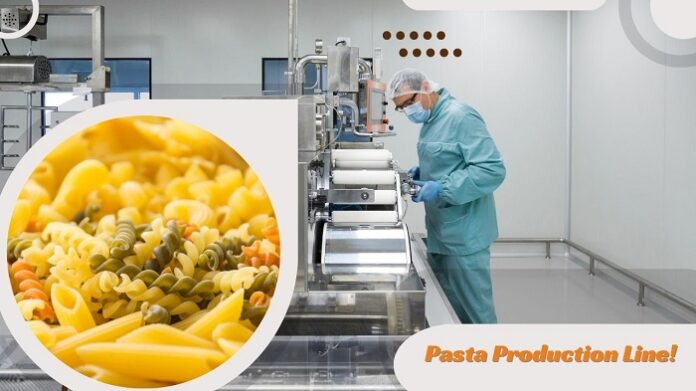In the realm of food manufacturing and culinary arts, the pasta production line stands out as a paramount innovation, streamlining the process of producing one of the world’s most beloved foodstuffs. This segment of our guide will explore the critical components that constitute a modern pasta production line, including dough preparation, extrusion, drying, and packaging processes. Through a detailed examination, we aim to provide a comprehensive understanding of each stage’s technical nuances and the vital role they play in ensuring the final product’s quality and consistency. Additionally, we will compare various types of pasta production technologies and their applications in different manufacturing scenarios, offering insights and recommendations to optimize efficiency and output in industrial pasta production settings.
What is a Pasta Production Line and How Does it Work?
A pasta production line is a highly automated and technologically advanced system designed for the mass fabrication of pasta. This intricate system encompasses several critical stages, each contributing to the transformation of simple ingredients into a variety of pasta shapes and types. The core components of a pasta production line include:
Mixing and Dough Preparation:
The initial stage involves blending flour with water (and sometimes eggs, for egg pasta) in precise ratios. This process is executed in a mixing machine that ensures a homogeneous mixture, forming a dough that is the foundation of pasta production.
Extrusion:
Following the dough preparation, the mixture is then transported to an extruder. Here, the dough is forced through dies—metal plates with holes in the shape of the desired pasta. This stage is crucial for defining the shape and texture of the pasta, with a range of dies available for making everything from spaghetti to intricate shapes like fusilli.
Cutting:
For long pasta types such as spaghetti or linguine, a cutter slices the extruded pasta into predetermined lengths. This step is adjusted according to the specific type of pasta being produced.
Drying:
Once shaped, pasta must be dried to reduce its moisture content and ensure stability during storage. Industrial pasta lines employ sophisticated drying chambers that carefully control temperature and humidity to achieve optimal drying without altering the pasta’s taste or texture.
Cooling:
After the drying process, the pasta needs to be gradually cooled to room temperature to prevent condensation and sticking. This is typically done in cooling tunnels.
Packaging:
The final step involves packaging the dried pasta. Automated machines weigh, fill, and seal the pasta in various packaging materials, ensuring the product is ready for distribution and sale.
Throughout this process, quality control measures are implemented at key points to ensure the pasta meets both safety standards and the desired quality specifications. The efficiency, automation, and precision of pasta production lines significantly impact the consistency of the final product, highlighting the evolution of pasta manufacturing from artisanal craft to industrial scale.
Types of Machines Used in Pasta Production
Exploring Different Types of Pasta Machines
Pasta manufacturing has evolved significantly with the introduction of various machines designed to streamline production processes. The machines used in pasta production can be broadly classified into manual, semi-automatic, and fully automatic machinery. Manual machines, often operated with hand-cranks, are best suited for small-scale or artisanal production. Semi-automatic machines require some manual intervention but increase efficiency and consistency. Fully automatic machinery, however, stands out for its operational efficiency, requiring minimal human intervention. This category includes mixers, extruders, cutters, and dryers that are integrated into continuous production lines for high-volume pasta manufacturing.
Advantages of Automatic Pasta Machinery
The introduction of automatic pasta machinery has revolutionized the pasta production industry, offering numerous advantages. First and foremost, automation enhances production efficiency by significantly increasing the output, thereby meeting high demand with consistent quality. Secondly, it reduces labour costs as fewer operators are required to oversee the production process. Automatic machines also improve the consistency and quality of the pasta by precisely controlling each stage of the process, from mixing and kneading to extrusion and drying. Additionally, these machines are versatile, capable of producing a wide variety of pasta shapes and sizes with minimal changeover time.
Benefits of Using Extrusion in Pasta Processing
Extrusion plays a pivotal role in modern pasta production, offering several key benefits. It allows for the creation of a multitude of pasta shapes and sizes by forcing dough through dies, from traditional forms like spaghetti and fettuccine to more complex shapes such as rotini and fusilli. The extrusion process also contributes to the texture and quality of the pasta, as the compression and shear forces involved in extrusion partially gelatinize the starches, leading to a desirable al dente texture upon cooking. Furthermore, extrusion enables more efficient incorporation of ingredients, such as vegetable purees or fortifying agents, allowing for the production of enhanced or functional pasta varieties.
Key Considerations for Setting Up a Pasta Production Line
Factors Affecting Output and Capacity
The output and capacity of a pasta production line are influenced by several critical factors. Firstly, the type and capabilities of the machinery utilized are paramount. Machines with higher automation and advanced technological features can significantly enhance production volume and efficiency. Secondly, the formulation of the dough impacts the production process; variations in moisture content, protein levels, and ingredient quality can affect both the machinery’s performance and the final product’s consistency. Additionally, the efficiency of the drying process is crucial, as improper drying can lead to product spoilage or reduced quality, impacting overall output. Streamlining the workflow and minimizing downtime for cleaning and maintenance are also essential considerations for maximizing production capacity.
Choosing the Right Raw Materials for Pasta Manufacturing
The selection of raw materials is a foundational step in the pasta manufacturing process, directly influencing the quality and character of the final product. High-quality durum wheat semolina is commonly preferred for its high protein content and gluten strength, which contribute to the pasta’s texture and cooking properties. Water quality, notably its mineral content and pH level, plays a substantial role in dough consistency and stability. Incorporating additives such as eggs, vegetable purees, or fortification agents can differentiate pasta products, catering to varying consumer preferences and nutritional demands. Consequently, sourcing and selecting the appropriate raw materials are crucial for achieving the desired pasta quality and broadening the product range.
Common Issues and Troubleshooting in Pasta Production Lines
Addressing Maintenance Challenges in Pasta Manufacturing Machines
In the realm of pasta manufacturing, the maintenance of machinery stands as a pivotal element, directly affecting production continuity and product quality. Regular and preventive maintenance schedules are paramount to identify wear and potential failures in critical components such as extruders, cutters, and dryers before they escalate into costly downtime. Implementing a comprehensive maintenance strategy involves the use of condition monitoring tools and predictive maintenance techniques. These approaches facilitate the early detection of issues through the analysis of vibration, temperature, and other machinery parameters, allowing for interventions that minimize operational interruptions. Furthermore, training staff on the intricacies of machinery operation and maintenance not only enhances their ability to troubleshoot issues swiftly but also promotes adherence to safety standards, ensuring a sustainable production environment.
Tackling Quality Control Concerns in Pasta Processing
Quality control in pasta processing embodies a systematic approach to ensuring the consistency and safety of the final product. This entails rigorous testing protocols spanning the entire production process, from raw material assessment to the evaluation of the finished pasta. Key parameters such as moisture content, color, texture, and shape must be closely monitored to align with predefined standards and consumer expectations. Advanced methodologies, including real-time spectrophotometry and rheological assessments, offer precise insights into dough properties and pasta quality. Implementing statistical process control (SPC) techniques also plays a critical role by enabling the identification of trends and variances in process data, facilitating timely adjustments to maintain product consistency. Adhering to stringent quality control measures not only mitigates the risk of product recalls but also fortifies brand reputation in a competitive marketplace.
Advanced Techniques and Innovations in Pasta Making
Exploring the realms of automation and customization in pasta production underscores a transformative shift towards more efficient, flexible, and personalized manufacturing processes. Automation technologies, from robotics to AI-driven systems, are increasingly being integrated into pasta production lines to enhance operational efficiency and precision. These systems excel in tasks such as ingredient dosing, dough kneading, shaping, and packaging, streamlining operations while minimizing human error and labor costs.
Customization, facilitated by advancements in digital and manufacturing technologies, is setting a new standard in pasta production. State-of-the-art extrusion and molding equipment, coupled with innovative cooking techniques, allow for the creation of pasta in a myriad of shapes, sizes, and textures tailored to diverse consumer preferences and dietary requirements. Additionally, the incorporation of 3D printing technology opens avenues for producing highly customized pasta forms, enabling manufacturers to cater to niche markets and individualized consumer demands.
Future Trends in Pasta Production Technology signify a continuous evolution toward more sustainable, efficient, and consumer-centric practices. Integration of IoT (Internet of Things) devices and sensors across production lines is anticipated to enhance real-time monitoring and analytics, optimizing resource use and reducing waste. Furthermore, the adoption of novel ingredients such as alternative proteins and gluten-free options aligns with evolving dietary trends, offering environmentally friendly and health-conscious alternatives. These technological advancements, combined with a focus on sustainability and customization, are poised to redefine the pasta production landscape, meeting the growing demands of a dynamic global market.





